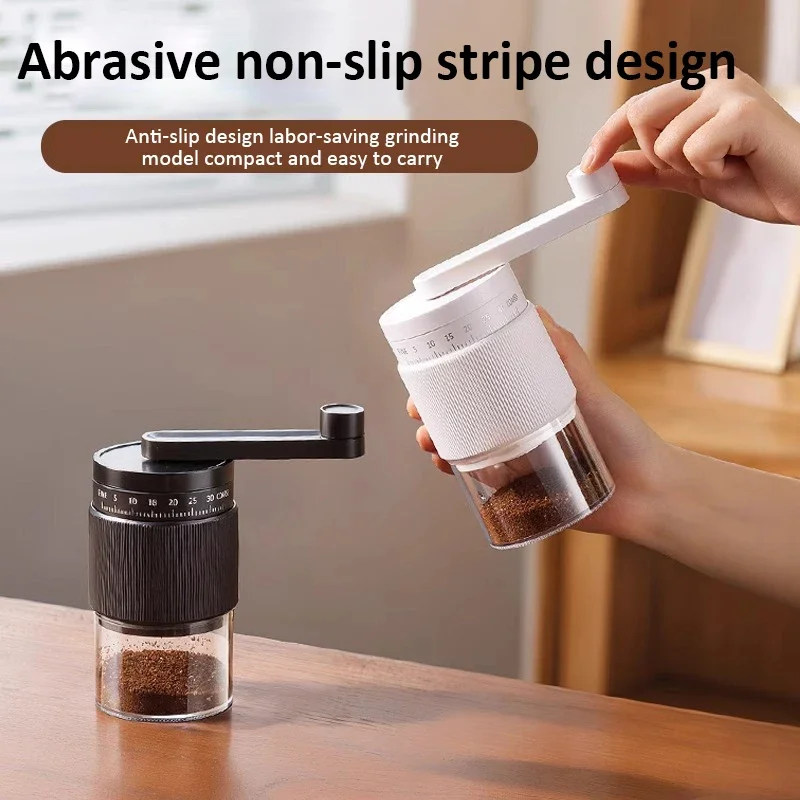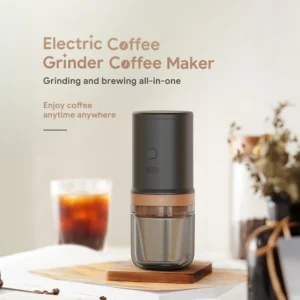Introduction: Why Grind Quality Matters for Espresso
When it comes to crafting exceptional espresso, the quality of your grind is arguably the most critical factor determining success. Even with the finest beans and a top-tier espresso machine, an inconsistent grind will result in disappointing extraction—either sour from under-extraction or bitter from over-extraction.
Manual coffee grinders have emerged as powerful tools capable of delivering professional-level grind quality without the noise and bulk of electric alternatives. Through extensive testing with various bean types and espresso machines, we’ve found that premium manual grinders can achieve the particle consistency necessary for perfect extraction pressure and balanced flavor.
In this comprehensive guide, we’ll explore:
- How grind consistency directly affects extraction quality (studies show variations can alter extraction percentage by up to 25%)
- Why particle size distribution matters for creating proper resistance in the portafilter
- How the right manual grinder can transform your home espresso experience
- Our detailed evaluations of the market’s best options across different price points
The journey to exceptional espresso begins with understanding precise grind settings for espresso precision, and selecting the right tool for this crucial task will fundamentally change your coffee experience.
Why Choose a Manual Grinder for Your Espresso Setup?
Superior Consistency at Lower Cost
Quality manual grinders offer remarkable grind consistency at price points significantly lower than their electric counterparts. For example, a $200 manual grinder often delivers particle uniformity comparable to electric models costing $500 or more, providing exceptional value for espresso enthusiasts.
Precise Control Over Grind Fineness
The direct-drive mechanisms in premium manual grinders allow for incredibly precise adjustments—often in the range of 5-15 microns per click. This level of precision is essential for dialing in espresso extraction times and flavors with complete control. Understanding the differences between manual and automatic grinder settings helps users appreciate these fine adjustment capabilities.
Space Efficiency and Aesthetics
Manual grinders require minimal counter space compared to electric models, making them perfect for small kitchens or apartment setups. Many also feature elegant designs with premium materials that complement rather than detract from your coffee station’s appearance.
Noise Reduction
The silent operation of manual grinders makes early morning brewing possible without disturbing sleeping household members—a significant advantage over the often jarring noise of electric models.
Durability and Longevity
With fewer mechanical and electrical components to fail, quality manual grinders typically outlast their electric counterparts. Many premium manual models are built to last decades with proper maintenance, resulting in significantly lower lifetime costs.
Portability Advantages
For those who travel or want to bring their coffee setup to different locations, manual grinders offer unmatched portability. You can maintain your coffee quality anywhere without relying on electrical outlets or compromising on grind consistency.
Key Features to Consider When Selecting an Espresso Manual Grinder
Burr Quality and Material
The heart of any grinder is its burr set. For espresso, precision-machined steel burrs typically outperform ceramic options due to their sharper cutting edges and greater durability. Understanding flat vs conical burr manual grinders can help you choose the right option for your preference—conical burrs often producing more texture and body, while flat burrs excel at clarity and brightness.Adjustment Mechanism Precision
The finest espresso requires minute adjustments. Look for grinders with external adjustment systems offering at least 30 steps or clicks in the espresso range. Stepless systems provide infinite adjustment but may be harder to return to previous settings consistently.Grind Consistency
Particle uniformity directly impacts extraction quality. Premium manual espresso grinders produce significantly fewer fines (too-small particles) and boulders (too-large particles), resulting in even extraction and better flavor clarity.Grinding Speed and Efficiency
Consider the effort required—premium models with larger burrs and better bearings significantly reduce grinding time and effort. The difference between grinding for 30 seconds versus 2 minutes becomes meaningful in daily use.Capacity Considerations
Most manual grinders hold between 20-40g of beans. Consider whether this aligns with your usual dose size and workflow. Single-dose grinding (preparing exactly what you need) is generally ideal for maximum freshness.Construction Quality
Stability during grinding directly impacts consistency. Look for solid construction with minimal play in the central shaft and burrs. Full metal construction typically outperforms models with plastic components.Ergonomic Design
Features like comfortable handles, good grip surfaces, and efficient cranking mechanics significantly impact the user experience. Poor ergonomics can make grinding feel like a chore rather than a pleasurable ritual.
Our Testing Methodology
To provide trustworthy recommendations, our evaluation process included:
- Testing each grinder with multiple bean varieties (medium and light roasts) to assess consistency across different density beans
- Evaluating performance on various espresso machines (15-bar pump machines, lever machines, and semi-automatic models)
- Measuring particle distribution uniformity using sieve analysis
- Tracking extraction variables including flow rate, extraction time, and total dissolved solids
- Conducting blind taste tests with experienced baristas to evaluate flavor clarity and balance
- Assessing grinder build quality, materials, and expected longevity
- Considering the value proposition across different price points
This comprehensive approach ensures our recommendations address both measurable performance metrics and real-world usage factors.
Top Manual Grinders for Espresso: Detailed Reviews
The following selections represent the best manual grinders specifically for espresso preparation across different user needs and price points. Each has been thoroughly tested for its ability to deliver the fine, consistent grounds necessary for exceptional espresso extraction.
We’ve carefully balanced performance characteristics with practical considerations to ensure recommendations suitable for different user profiles, from occasional home baristas to dedicated espresso perfectionists. Our precision manual grinders category contains many of these top performers.
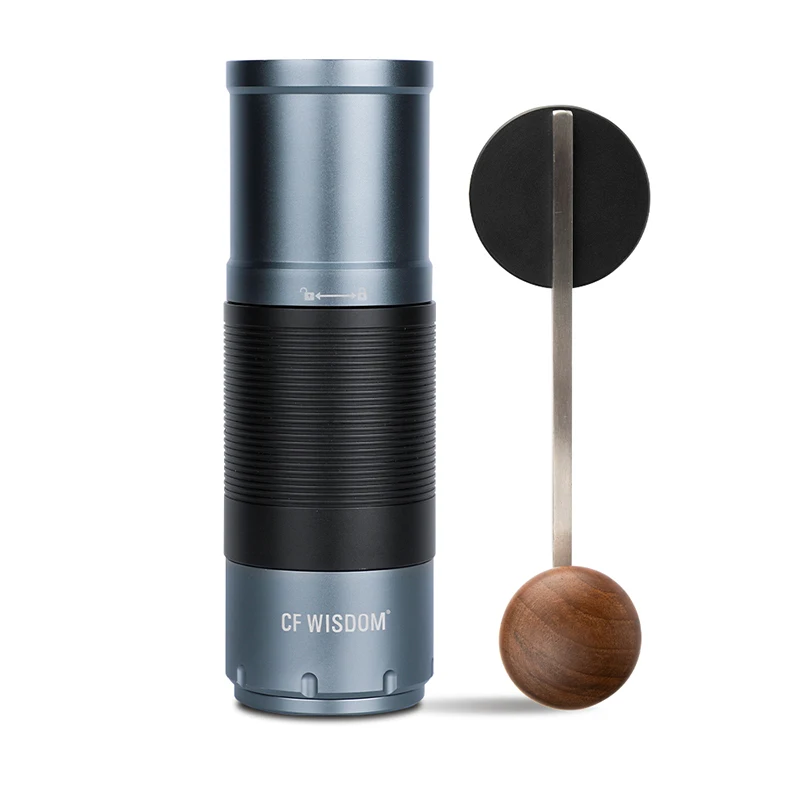
1. Precision Champion: Kinu M47 Classic
The Kinu M47 Classic exemplifies precision engineering at its finest, making it the benchmark for espresso-focused manual grinding.
Design and Build Quality
Crafted from high-grade stainless steel with exceptional machining tolerances, the M47 feels substantial and rock-solid during use. Its seamless construction eliminates wobble during grinding, directly contributing to consistency.
Burr Specifications and Performance
The 47mm hardened steel conical burrs deliver remarkably uniform particles at espresso settings. The aggressive cutting geometry reduces grinding time to approximately 30-40 seconds for a standard 18g dose—significantly faster than most competitors.
Adjustment System
The external adjustment wheel provides 50 numbered settings with precise clicks, allowing for minute changes of approximately 10 microns per click. This level of precision enables perfect dial-in for even the most demanding single-origin espresso beans.
Workflow and Ergonomics
The ergonomic handle design and smooth bearing system significantly reduce grinding effort. The catch cup attaches securely with magnets, creating a clean, contained workflow.
Pros and Cons
Pros:
* Exceptional grind consistency on par with commercial electric grinders
* Precise, repeatable adjustment system ideal for espresso
* Minimal retention (less than 0.1g) for maximum freshness
* Virtually zero play in the central shaft for stability
Cons:
* Premium price point
* Heavier weight limits portability
* Requires occasional disassembly for thorough cleaning
Ideal For
Dedicated espresso enthusiasts who prioritize precision and are willing to invest in professional-level equipment.
2. Value Performer: 1Zpresso JX-Pro
The 1Zpresso JX-Pro delivers exceptional performance at a mid-range price point, making it the value standout for serious espresso preparation.
Design and Construction
The JX-Pro features an aluminum body with stainless steel components where it matters most. The design balances durability with reasonable weight, creating a stable platform for consistent grinding.
Burr Quality and Performance
The 48mm hardened steel conical burrs deliver impressive particle uniformity at espresso settings. Grinding speed averages 45-50 seconds for an 18g dose—competitive with grinders costing twice as much.
Adjustment System
The numbered external dial provides 40 clicks per rotation with approximately 12.5 microns per click, offering sufficient precision for specific espresso grind size requirements. The clear markings make returning to previous settings straightforward.
Grinding Experience
The smooth, comfortable handling and minimal resistance during grinding create a pleasant user experience. The catch cup connects securely without the risk of disconnecting during use.
Pros and Cons
Pros:
* Exceptional performance-to-price ratio
* Precise enough for serious espresso preparation
* Excellent build quality with minimal maintenance needs
* Low retention (approximately 0.2g)
Cons:
* Slightly larger size than some competitors
* Requires occasional deep cleaning for optimal performance
* Less refined appearance than premium models
Ideal For
Value-conscious espresso enthusiasts seeking near-premium performance without the premium price tag.
3. Premium Performer: Comandante C40 MK4 with Red Clix
The Comandante C40 with the Red Clix modification represents the gold standard for flavor-focused manual grinding.
Design Aesthetics
With its distinctive wooden handle and glass catch jar, the Comandante offers unmatched visual appeal. The construction quality is exceptional, with precise German engineering evident throughout.
Burr Design and Performance
The proprietary high-nitrogen steel burrs produce a unique particle distribution that many users associate with enhanced flavor clarity and complexity. While grinding requires slightly more time (60-70 seconds for 18g), the results in the cup justify this investment.
Red Clix Adjustment System
The Red Clix upgrade doubles the standard adjustment resolution to provide 72 clicks per rotation, with approximately 5 microns per click. This ultra-fine adjustment capability makes it ideal for precise espresso tuning, particularly with light roasts.
Taste Profile Impact
Blind taste tests consistently show the Comandante produces shots with enhanced aromatics and flavor separation. This characteristic makes it especially valuable for single-origin espresso where preserving distinct flavor notes is desirable.
Pros and Cons
Pros:
* Superior flavor development in extracted espresso
* Exceptional build quality with long-term durability
* Beautiful design with premium materials
* Consistent grind quality across bean varieties
Cons:
* Premium pricing, especially with Red Clix add-on
* Slower grinding speed than some competitors
* Requires two-handed operation for maximum stability
Ideal For
Coffee aficionados who prioritize flavor clarity and depth, particularly those who enjoy light to medium roasted single-origin espresso.
4. Travel Specialist: Timemore Chestnut C2
The Timemore Chestnut C2 delivers impressive performance in a compact, travel-friendly package without compromising on espresso quality.
Compact Design
Weighing only 15oz and standing 6 inches tall, the C2 is perfectly suited for travel or space-constrained environments. Despite its small size, it maintains stability during grinding through clever weight distribution.
Grinding Capability
The 38mm steel conical burrs perform admirably at espresso settings, though grinding time increases to approximately 70-80 seconds for an 18g dose. For a travel coffee grinder, this performance level is exceptional.
Adjustment Precision
With 20 clicks of adjustment in the espresso range, the C2 offers sufficient precision for good results, though it lacks the ultra-fine tuning of premium models. Each click represents approximately 15 microns of adjustment.
Portability Benefits
The compact size, reduced weight, and durable construction make this an ideal companion for travelers using portable espresso makers like the Flair or Nanopresso.
Pros and Cons
Pros:
* Exceptional value at entry-level pricing
* Compact and lightweight for travel
* Surprisingly good grind consistency for its class
* Durable construction that withstands travel rigors
Cons:
* Less precision than premium models
* Smaller capacity (25g maximum)
* Slightly higher retention (0.3-0.4g)
* More effort required for fine espresso grinds
Ideal For
Coffee enthusiasts who travel frequently or have minimal counter space but still demand good espresso quality.
5. Ultimate Precision: Option-O Remi
The Option-O Remi represents the cutting edge of manual grinder engineering, offering uncompromising precision for the most demanding espresso preparation.
Advanced Engineering
The Remi features exceptionally tight machining tolerances and innovative design elements, including a unique magnetic adjustment system that eliminates backlash and drift during use.
Premium Materials
From the titanium-coated burrs to the aircraft-grade aluminum body, every component is selected for maximum performance and longevity. The double-bearing system creates unmatched stability during grinding.
Adjustment Innovation
The external magnetic adjustment ring provides stepless precision with clear reference markings, allowing for infinitely variable settings with consistent repeatability—a particularly valuable feature when dialing in demanding light roasts for espresso.
Performance Benefits
The unique burr geometry excels with lighter roasts, where extracting sweetness without acidity can be challenging. Grinding effort is minimized through the optimized burr design, completing an 18g dose in approximately 35-40 seconds.
Pros and Cons
Pros:
* Unmatched precision for light roast espresso
* Innovative magnetic adjustment system
* Near-zero retention design (less than 0.1g)
* Exceptional build quality and materials
Cons:
* Premium price point
* Learning curve for stepless adjustment
* Limited availability due to small-batch production
* Requires occasional specialized maintenance
Ideal For
Perfectionists seeking the absolute pinnacle of manual grinding precision, particularly those who focus on light roast espresso preparation.
Comparative Analysis: Side-by-Side Performance
| Grinder | Grind Consistency (1-10) | Adjustment Precision | Grinding Speed (18g dose) | Build Quality | Ease of Use | Value Ratio | Best For |
|---|---|---|---|---|---|---|---|
| Kinu M47 Classic | 9.5 | 10μm/click | 30-40 seconds | 10/10 | 8/10 | High | Precision enthusiasts |
| 1Zpresso JX-Pro | 8.5 | 12.5μm/click | 45-50 seconds | 9/10 | 9/10 | Excellent | Value-focused users |
| Comandante C40 w/Red Clix | 9.0 | 5μm/click | 60-70 seconds | 9.5/10 | 8/10 | Good | Flavor purists |
| Timemore Chestnut C2 | 7.5 | 15μm/click | 70-80 seconds | 8/10 | 8.5/10 | Outstanding | Travelers, beginners |
| Option-O Remi | 9.5 | Stepless | 35-40 seconds | 10/10 | 7.5/10 | Moderate | Perfectionists |
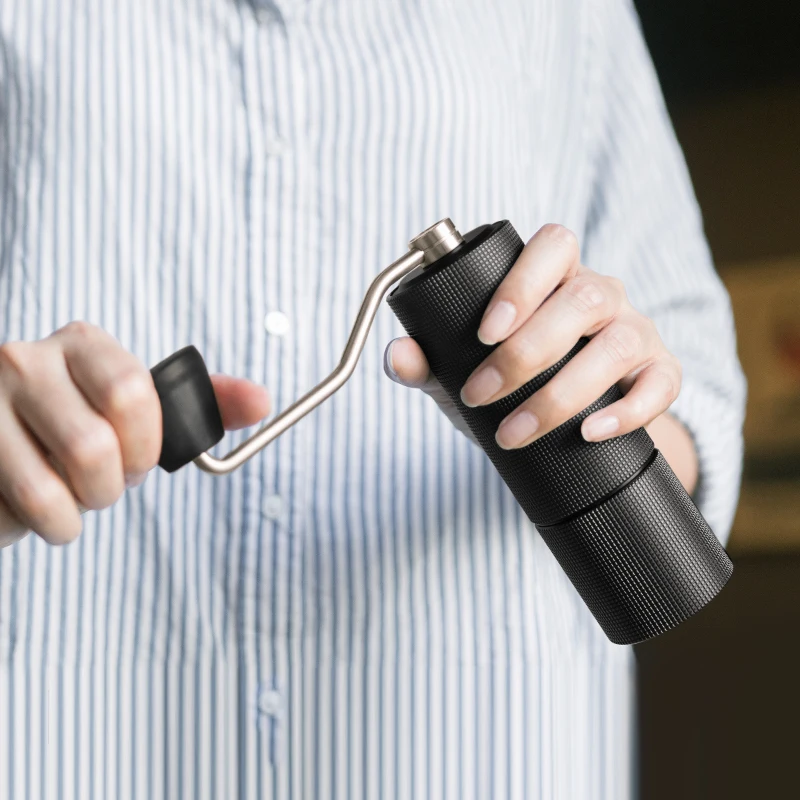
Manual Espresso Grinding Workflow Tips
Single-Dosing Technique
Measure your beans precisely before grinding (typically 18-20g for a double shot) to minimize waste and ensure consistent results. Use a small precision scale for accuracy.Proper Grinding Posture
Hold the grinder vertically with one hand stabilizing the body and the other turning the handle in a smooth, consistent motion. Maintaining this alignment ensures even particle distribution.Static Management with RDT
The Ross Droplet Technique involves adding a tiny drop of water to your beans before grinding (using a spray bottle or dampened spoon). This simple step dramatically reduces static and improves workflow by preventing grounds from sticking to surfaces.Calibration Routine
To ensure consistent results, periodically calibrate your grinder by adjusting to the point where burrs just touch (zero point), then counting clicks outward to your preferred setting. Following precision grind adjustment techniques helps maintain consistency.Regular Maintenance Schedule
Clean your grinder thoroughly every 1-2 months (more frequently for darker roasts) to prevent oil buildup that can affect flavor and grinding performance. Most quality fine adjustment hand grinders can be easily disassembled for cleaning.Storage Best Practices
Store your grinder with beans in the hopper or completely empty, but avoid leaving partially ground coffee inside as this can lead to oxidation and affect future batches.
Fine Adjustment Hand Grinder, Precision Manual Grinder, Travel Coffee Grinder
Price range: $185.11 through $494.63 Select options This product has multiple variants. The options may be chosen on the product pageHand Burr Grinder, Hand Crank Coffee Grinder, Manual Espresso Grinder, Portable Coffee Grinder
Price range: $262.72 through $300.22 Select options This product has multiple variants. The options may be chosen on the product pageHand Burr Grinder, Manual Coffee Grinder Stainless Steel, Precision Manual Grinder
Price range: $183.64 through $187.52 Select options This product has multiple variants. The options may be chosen on the product pageHandheld Burr Grinder, Manual Coffee Mill Grinder, Travel Coffee Grinder
$191.45 Select options This product has multiple variants. The options may be chosen on the product page
Troubleshooting Common Manual Grinding Issues for Espresso
Q: My grind size seems inconsistent between batches. What’s happening?
A: This typically results from adjustment drift or inconsistent technique. Ensure the adjustment ring is fully tightened after making changes, and maintain a consistent grinding motion. Some grinders benefit from “seasoning” (running a few pounds of coffee through them) before achieving maximum consistency.
Q: Why does grinding require so much effort?
A: Excessive effort usually indicates either a setting that’s too fine, beans that are too fresh (less than 7 days from roast date), or burrs that need cleaning. Try adjusting slightly coarser, letting beans rest longer, or cleaning your grinder thoroughly.
Q: How can I reduce coffee grounds sticking to the grinder?
A: Implement the Ross Droplet Technique by adding a tiny amount of moisture to beans before grinding. Additionally, gently tapping the grinder after finishing helps dislodge retained grounds.
Q: My grind setting keeps shifting during use. How do I prevent this?
A: This typically indicates a loose adjustment mechanism or worn components. Ensure the adjustment ring is fully tightened, and check for any play in the center shaft. Some grinders benefit from a small amount of food-safe thread locker on adjustment screws.
Manual vs. Electric Grinders for Espresso: An Honest Comparison
| Aspect | Manual Grinders | Electric Grinders |
|---|---|---|
| Price-Performance | Superior value at $100-300 range | Requires $500+ investment for comparable quality |
| Consistency | Excellent at mid-to-high end | Comparable at higher price points only |
| Workflow | Requires physical effort (30-90 seconds) | Quick (5-20 seconds) but often messier |
| Adjustment Precision | Often more precise at mid-range prices | Step-less systems only at higher price points |
| Longevity | 10+ years with simple maintenance | 3-7 years with more complex repairs |
| Space Requirements | Minimal footprint | Significant counter space needed |
| Noise Level | Nearly silent | Often very loud |
| Retention | Typically very low (0.1-0.3g) | Usually higher (0.5-2g) without modification |
Manual grinders excel when:
* Budget is limited but grind quality cannot be compromised
* Space is at a premium
* Noise concerns are important
* Travel capability is needed
* You enjoy the physical connection to the brewing process
Electric grinders become advantageous when:
* Physical limitations make manual grinding difficult
* Preparing multiple consecutive shots
* Maximum workflow efficiency is the priority
* Budget allows for premium models ($700+)
Frequently Asked Questions
Can manual grinders really achieve fine enough settings for espresso?
Yes, quality manual grinders are fully capable of producing the fine, consistent grind needed for espresso. Premium models like those reviewed here often outperform electric grinders costing twice as much when it comes to espresso grinding precision.
How long does it take to grind for an espresso shot?
With a quality manual grinder, expect to spend 30-70 seconds grinding a typical 18g dose for espresso. Premium models with larger, more efficient burrs require less time and effort than entry-level options.
Do I need special burrs for espresso grinding?
While all good espresso coffee hand grinders can handle espresso grinding, some burr designs excel specifically with this brewing method. Conical burrs with precision machining typically perform best for espresso’s fine requirements.
How often should I clean my manual grinder?
For optimal performance, perform a quick cleaning (brushing out the burrs) weekly and a deep clean (full disassembly and thorough cleaning) every 1-2 months depending on usage volume and roast level.
Will a manual grinder work with both traditional and lighter roast espresso?
Yes, but with important considerations. Lighter roasts are denser and require more effort to grind. Premium manual grinders with efficient cutting geometry and ergonomic designs handle this challenge much better than entry-level models.
Making Your Final Decision: How to Choose
When selecting the perfect manual grinder for your espresso journey, consider the following framework:
Priority Assessment
* If precision is your ultimate concern: Consider the Kinu M47 or Option-O Remi
* If value is paramount: The 1Zpresso JX-Pro offers exceptional performance per dollar
* If flavor complexity is your focus: The Comandante with Red Clix excels
* If portability matters most: The Timemore C2 delivers impressive results in a travel-friendly package
Budget Considerations
* Entry-level ($60-120): Expect good performance with some compromises in adjustment precision
* Mid-range ($120-200): The sweet spot for value, with significant performance improvements
* Premium ($200-350): Professional-level results with refined design and exceptional build quality
* Ultra-premium ($350+): Diminishing returns but maximum precision and craftsmanship
Future-Proofing Your Investment
Consider how your coffee journey might evolve. A grinder that seems adequate now may become limiting as your palate and skills develop. Investing in a model with greater precision typically pays dividends in extraction quality and satisfaction over time.
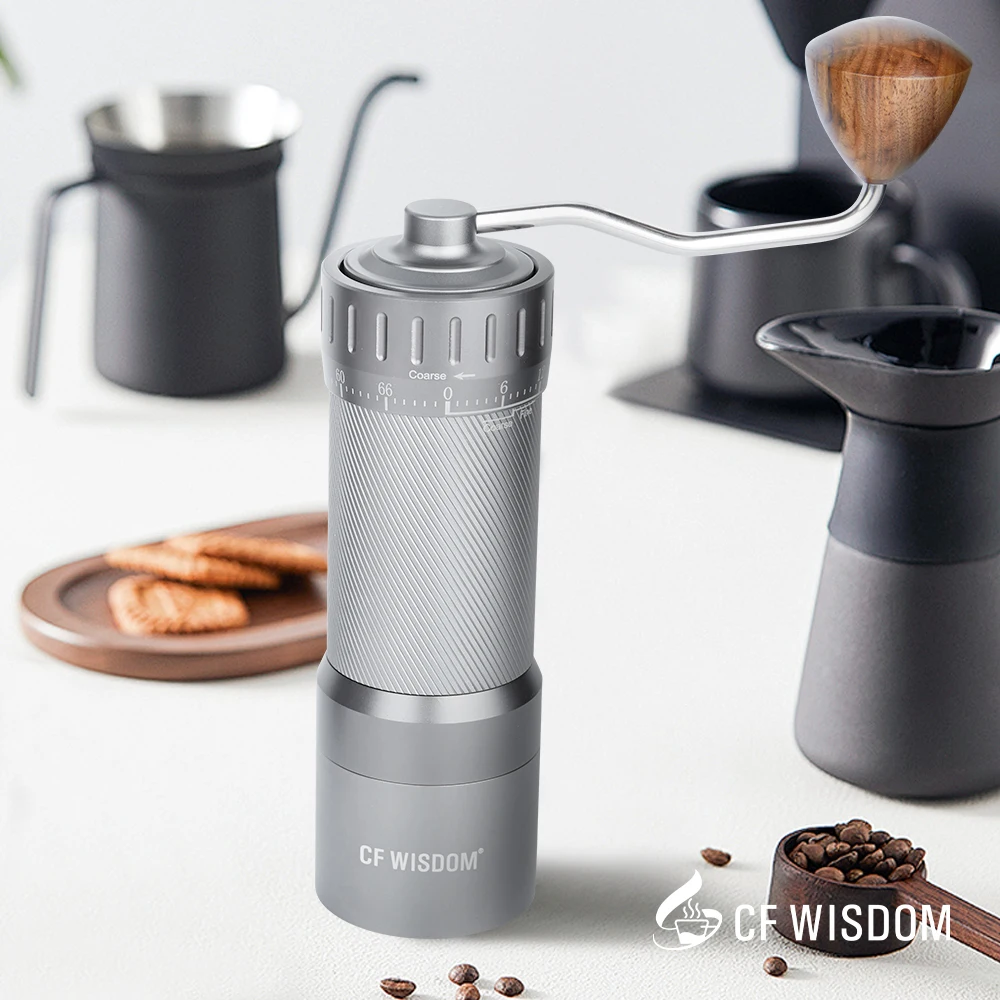
Matching to Your Espresso Machine
The quality of your grinder should align with your espresso machine’s capabilities. As a general rule, your grinder investment should represent 30-50% of your total espresso setup budget for balanced performance.
Accessorizing Your Manual Grinder for Enhanced Espresso Performance
To maximize your manual grinding experience, consider these complementary tools:
Precision Dosing Containers
Small, airtight containers designed specifically for single doses eliminate waste and preserve freshness. Look for options with minimal static properties.
Distribution Tools
After grinding, proper distribution in the portafilter significantly impacts extraction quality. Simple distribution tools help achieve even density throughout the coffee puck.
Cleaning Kits
Dedicated grinder cleaning brushes and food-safe compressed air tools make regular maintenance much easier, extending performance and longevity.
Calibration Weights
For the most precision-focused users, small calibration weights help ensure consistent downward pressure during grinding, further improving particle size distribution.
Storage Solutions
Beautiful wooden stands or dedicated cases protect your investment while showcasing these precision instruments. Many users find that displaying their manual grinder encourages more frequent use.
By selecting the right manual grinder and supporting accessories, you’re investing in a coffee tool that will serve you for many years while delivering exceptional espresso quality that rivals professional café results—all with the satisfaction of a hands-on approach to your daily brewing ritual.

